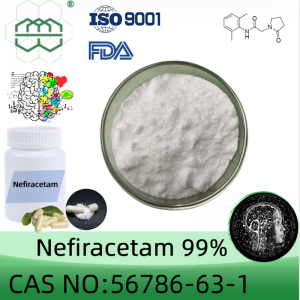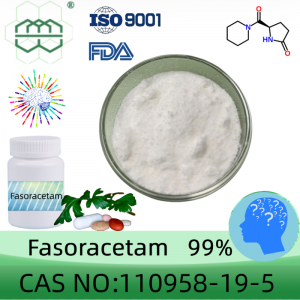Coluracetam powder manufacturer CAS No.: 135463-81-9 99%purity min. for supplement ingredients
Product Parameters
|
Product name |
Coluracetam |
|
Other name |
MKC-231; 2-oxo-N-(5,6,7,8-tetrahydro-2,3-dimethyl-furo[2,3-b]quinolin-4-yl)-1-pyrrolidineacetamide |
|
CAS No. |
135463-81-9 |
|
Molecular formula |
C19H23N3O3 |
|
Molecular weight |
341.4 |
|
Purity |
99.0% |
|
Appearance |
White powder |
|
Application |
Dietary Supplement Raw Material |
Product introduction
Coluracetam is a member of the racetam family of nootropic compounds and is also known as MKC-231. It was developed by Kobe Pharmaceutical Company in Japan with the aim of treating AD and cognitive impairments.
The exact mechanism of action of Coluracetam is not fully understood, but it is believed to primarily work by modulating the cholinergic system. It is thought to increase levels of acetylcholine, a key neurotransmitter in the brain that is closely associated with learning and memory functions. Coluracetam may achieve this by increasing the number and activity of choline uptake transporters, leading to enhanced release of acetylcholine and improved signal transmission between neurons.
Although research on Coluracetam is still relatively limited, some early experiments and animal studies have suggested potential neuroprotective and cognitive-enhancing effects. Some studies have found that Coluracetam has a certain improvement in memory impairments in AD models.
In terms of clinical research, studies on Coluracetam have mainly focused on animal experiments and early human trials. More research and evidence are needed to determine its safety and effectiveness in humans. Currently, Coluracetam has not been approved for clinical use, but it is widely used as a nootropic supplement for cognitive enhancement in some countries.
Regarding safety, there is limited research data available on the side effects and long-term risks of Coluracetam. Based on current knowledge, Coluracetam is generally considered relatively safe, but it is still recommended to consult with a healthcare professional, especially if you have any health conditions or are taking other medications, before using it.
In summary, Coluracetam is a nootropic compound that is being studied for its potential in treating AD and cognitive impairments. While some early research suggests cognitive enhancement and neuroprotective effects, more studies are needed to establish its true efficacy and safety.
Feature
(1) High Purity: Coluracetam is prepared using advanced extraction and manufacturing processes, ensuring a high level of purity. This high purity contributes to improved bioavailability and minimizes the occurrence of adverse reactions.
(2) Safety: Coluracetam is considered safe for human consumption. Extensive studies have demonstrated its low toxicity and minimal side effects within the recommended dosage range.
(3) Stability: Coluracetam preparations exhibit excellent stability, maintaining their activity and effectiveness under various environmental and storage conditions. This stability ensures consistent and reliable performance over time.
(4) Rapid Absorption: Coluracetam is readily absorbed by the human body. Upon ingestion, it quickly enters the bloodstream through the intestinal tract and efficiently distributes to different tissues and organs, facilitating its desired effects.
(5) Cognitive Enhancement: Coluracetam is known for its potential to enhance cognitive function, including improvements in memory, learning capacity, and focus. It is often sought after by individuals looking to optimize their mental performance.
(6) Neuroprotective Effects: Research suggests that Coluracetam may possess neuroprotective properties, which could help safeguard against age-related cognitive decline and support overall brain health.
(7) Potential Treatment for Cognitive Disorders: Coluracetam shows promise as a potential therapeutic option for cognitive disorders, such as Alzheimer's disease and other neurodegenerative conditions. However, further research is needed to fully understand its effectiveness in treating these specific conditions.
Applications
Coluracetam is currently being used in various applications and shows promising prospects for the future. It is primarily utilized as a cognitive enhancement supplement, sought after by individuals looking to improve their memory, focus, and learning abilities. The compound's ability to modulate the cholinergic system is believed to contribute to its cognitive-enhancing effects.
In addition to its current applications, Coluracetam has shown potential in the treatment of neurodegenerative disorders such as Alzheimer's disease and cognitive impairments. Research suggests that Coluracetam may possess neuroprotective properties, making it an intriguing candidate for further exploration in these conditions. However, further studies and clinical trials are needed to determine its effectiveness, safety, and optimal usage protocols in clinical settings.
The aging population has increased the demand for interventions that can mitigate age-related cognitive decline. Coluracetam's neuroprotective effects and potential to support neural repair mechanisms make it an interesting avenue for research in addressing cognitive decline associated with aging.
Furthermore, preliminary research suggests that Coluracetam may have benefits for mood disorders such as depression and anxiety. However, more comprehensive studies are required to evaluate its efficacy and establish appropriate treatment protocols in these indications.
Coluracetam's potential extends to neurorehabilitation programs as well. Its ability to enhance neuronal signaling and potentially support neural repair mechanisms makes it a candidate for use in the rehabilitation of individuals with brain injuries or strokes.
While Coluracetam shows promise in various applications, it is important to emphasize the need for further research, to validate its efficacy, safety, and optimal usage protocols. Regulatory approvals would also be required for its clinical use in specific indications.



















